For the fourth year in a row, Ukraine is fighting an undeclared war with Putin’s Russia. But it seems that Ukrainian media are more interested in the colors of Justin Trudeau’s socks, Trump and Putin’s body language at the G-20 meeting in Hamburg, or permanent scandals with local pop-singers giving concerts in Russia.
All that media frenzy overshadows the real war in Donbas and, worst of all, the fallen soldiers who gave their lives so that ordinary citizens have a possibility to visit cafes, cinemas, theaters. It is even practically impossible to know the names of the killed military men as monosyllabic reports from the spokesperson on ATO-related issues do not disclose the details on who and how was slain in this so-called “hybrid war.”
Still, in 2017 the Armed Forces of Ukraine are in far more better shape than they were at the beginning of 2014. Certainly, the nature of fighting has seriously changed – the active hostilities four years ago have been replaced by a trench war.

For ease of understanding the situation at the front line, let’s divide it into four sectors: the Luhansk direction, the Svitlodarsk salient, the Donetsk direction, and Mariupol. Here we will focus mostly on the recent developments in the Luhansk direction.
I. The changing status quo in Luhansk Oblast
After heavy fighting at the end of August in 2014 near Luhansk and January in 2015 for control over Bakhmutka highway (R-66), the overall situation in the oblast was relatively serene. There were a few factors facilitating such a status-quo. One of them is the river of Siverskyi Donets, which acts as a natural deterrent. From a military perspective, the active offensives, having such a barrier as a river, would bring too many losses, as artillery units have precisely sighted on the possible spots for attacks. So, during these two years, the units of Ukraine’s Ground Forces and the Russian-backed militants have concentrated on defending the areas they already have had under their control.

During the phase of the trench war, both sides had worked on advancing into the “gray zones.” At the end of May, the Ukrainian units of the 93d mechanized infantry brigade, hardened in the battles for the Donetsk Airport, advanced near Krymske village. At this direction, the positions of Ukrainian Army near Krymske have traversed the river of Siverskyi Donets, and this is the only place where they are able to be active.
These areas should have been already under Ukraine’s control according to Minsk I Agreements but were seized by Russian-militant forces in the autumn of 2014.
When the commanders of the Russian militants understood that the Ukrainian infantry had taken important commanding heights near Zholobok village, allowing them to exercise control over this part of the R66 highway and even cut off supplies to their forces concentrated in Pervomaisk, Kadiyivka (former Stakhanov), they resorted to their favorite and many-times tested method by disseminating false reports in the controlled media of the separatist “republics” on the alleged full-fledged offensive of Ukrainian government forces. This was used as a precondition for shelling the positions of Ukraine’s Armed Forces with prohibited calibers, even Zholobok village suffered considerably though there were no Ukrainian soldiers in it. The Russian-militant forces claimed that the Ukrainian infantry suffered heavy losses, and spread scaremongering fakes in their medias that they even faced Polish mercenaries under the command of the US colonels and that the captured militants were mutilated and then killed by the Right Sector, a nationalist Ukrainian battalion which was turned into a bogeyman of sorts in the Russian and pro-Russian media. This was done with the only goal to cover their untalented military management.
After a few days of heavy yet fruitless attacks at the positions of the 93d brigade at the commanding heights near Zholobok, the combined Russian-militant forces launched plan B by dispatching sabotage and reconnaissance groups (SRG) towards the positions of the 93d brigade. The Ukrainian infantry foresaw such a turn of events and on June 24, they held a counter-operation against an enemy SRG and captured a Russian soldier named Viktor Ageyev. Just as before, Russia categorically denied any involvement of its soldiers in the war in Donbas. However, Ageyev himself has confirmed he is a contract soldier and was on active duty in Donbas.
Read more: Russian contract soldier captured in Donbas confirms he was on active duty
These days the situation in Luhansk oblast has calmed down. Combined Russian-militant forces have suffered a tactical defeat – the units of 93d mechanized infantry brigade have taken fire control over the R66 highway.
II. The ever-hot Svitlodarsk salient
Since December 2016, the situation near Svitlodarsk remains tense. Regarding this hotspot, there is a need to make a small but important digression. Even after leaving Debaltseve in 2016, the Ukrainian Army still preserves the option to deliver sharp and severe blows aiming at driving a wedge in between the so-called “LNR” from “DNR” with their following encirclement. Well knowing this, the Russian-militant forces had constantly been trying to drive out the Ukrainian Army out of the Svitlodarsk salient to deprive it of that option. This accounts for unremitting hostilities in this sector.

Even being under the conditions of a total ban on the use of heavy artillery, the units of government forces have been squeezing the Russian-militant forces out of their positions inch by inch, gradually seizing the commanding heights and getting closer to Debaltseve, which, again, according to the Minsk I Agreements should be under Ukraine’s control. The militants freely use heavy artillery, provoking the Ukrainian infantry, but when they are eventually answered by counterattacks, they ask for a ceasefire.
This plan failed last December when the SRGs of the Russian-militant forces under the cover of artillery tried to seize the forward positions of the 54th mechanized infantry brigade. This turned out to be a total disaster for the Russian-militant side, as their SRGs were rebuffed and the units of 54th brigade successfully counterattacked, having seized a few advantageous positions. As of now, the overall status at the Svitlodarsk salient is more or less stabilized till the next attempt of the Russian-militant forces to advance.
III. The ever-suffering Avdiivka
Avdiivka is the hottest spot in Donbas war map, with the recent major flare in fighting having taken place on 29 January 2017.

Having survived the terrible days at the end of January 2017, the inhabitants of Avdiivka may breathe more freely. During those hellish days, Russian-militant forces conducted severe attacks at the positions of 72nd mechanized infantry brigade at the Promzona, an industrial location outside the city. with an active use of artillery and tanks. A considerable part of mortars and howitzer shells fell on the houses of the civilian residents in Avdiivka, taking their lives and destroying the infrastructure of the city.
Read more: Escalation in Avdiivka, Eastern Ukraine: key facts and sources
After several successful counterattacks of the Ukrainian infantry, the Russian-militant forces lost crucial positions near the Yasynuvata junction which significantly strengthens the ability of the 72nd brigade to control the important road between Donetsk and Horlivka with fire. Correspondingly, the supplies routes have been changed, worsening the ammo provision for garrisons in Yasynuvata and Horlivka.
Understanding that a full-frontal attack on the positions of Ukrainian troops at the Promzona will be difficult, the commanders of the Russian-militant forces tried to deliver a flanking blow at Kamianka village to the north-east of Avdiivka. They were met by a strong rebuttal and retreated with no results. Despite active hostilities having decreased, the illusory cease-fire may end up in every given second.
Read also: Why Avdiivka is the most vulnerable spot for the Russian-separatist army in Ukraine
IV. The southern bulwark – Mariupol
The city of Mariupol is another hotspot in Donbas. Here, ceasefires are interspersed with heavy fighting. No one can be sure what’s happens next. The locals have adapted to this uncertainty. The single yet crucial difference between Mariupol and other frontline cities like Avdiivka, Mariinka, or Krasnohorivka is that Ukrainian troops were able to drive the Russian-militant forces out of the town.

In result, the center of gravity of active hostilities had shifted to small villages as Shyrokyne, Kominternove, Sakharka, and Hnutove. As everywhere else along the frontline, the combined Russian-militant forces actively use heavy artillery against the government forces. Because of the chaotic character of shelling, the civilian residents have been suffering the most even taking into consideration the announcement of the so-called “bread ceasefire.”
Summing up, it would appropriate to say that, despite the declining media attention, the war in Donbas is ongoing and regularly takes the lives of the soldiers and civilians. This fact should be well remembered by every Ukrainian citizen who has a possibility to live his easy-going life.





